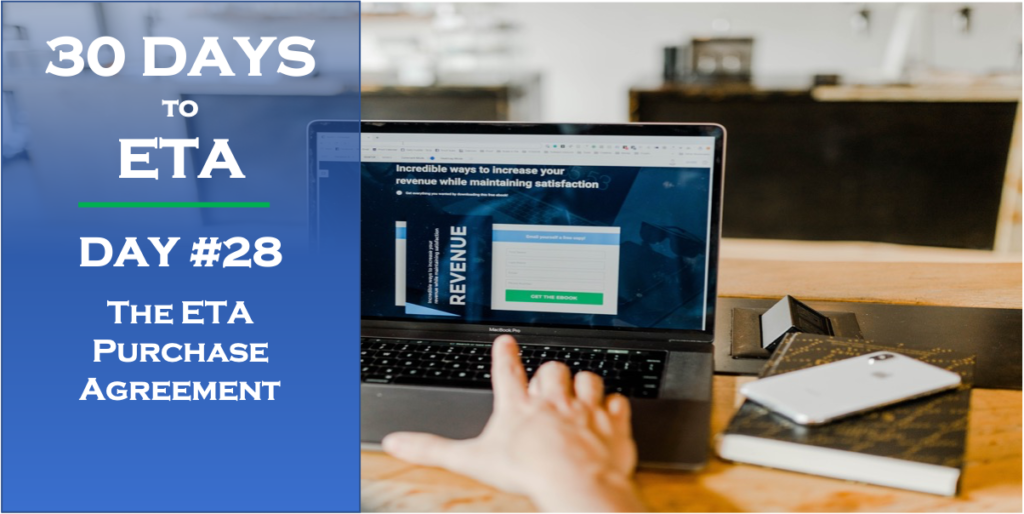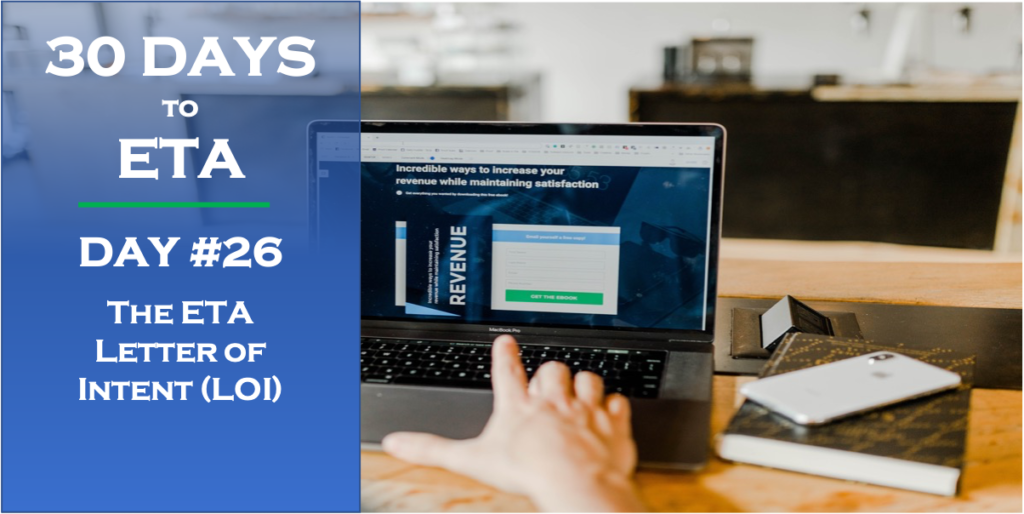If you’ve been reading along in this 30 Days to ETA series, you know that in the Day #29 post I shared congratulations — You made it to Entrepreneurship Through Acquisition (ETA)! But before you start popping those champagne bottles, you’d better have a plan for the next day of running your business. As an Acquisition Entrepreneur you should have the first 100 days lined out — Something I call The ETA First 100 Days (You can read the previous post by CLICKING HERE). Now that we’re officially at Day #30, Congratulations are truly in order! As an Acquisition Entrepreneur you should relish the accomplishment. So, in today’s 30 Days to ETA post, we’re going to review the last 30 days with a Summary… Enjoy!
Entrepreneurship Through Acquisition (ETA) is a journey to buy a business, and it seems like everyone I know that goes through ETA has a slightly different experience. At Tip of the Spear Ventures Mergers & Acquisitions practice, I see some who move through the process fast, stumbling into success in a matter of weeks after executing a brilliant ETA Strategy. Others move slowly, spending years of their lives perfecting the art of Acquisition Entrepreneurship. Some go back to college for years getting a master’s level education in business, and others get started before they even finish high school.
Yes, I’m here to tell you that there is no one 30 Days to ETA road that leads to success for everyone. Acquisition Entrepreneurship is a diverse and rewarding journey, but even so, there are certain hallmarks of the entrepreneurship experience that almost everyone goes through at one point or another. What follows is a summary of where we visited along this 30 Days to ETA journey.
30 Days to ETA | Day #1 – Startup or Acquisition?
My goal for this 30 Days to ETA Series is simply to walk you through the journey of sourcing, searching, and ultimately buying a business. However, make no mistake about this whole world of Mergers & Acquisitions… There is nothing “simple” about it! And in this Day #1 post we’ll explore whether as an Entrepreneur you should Startup or Acquisition — That is, should you start your own business from scratch (i.e., Startup) or buy a business that’s already in existence (i.e., Acquisition).
30 Days to ETA | Day #2 – Leading Your Business
In this 30 Days to ETA post, we’ll explore the topic of leading your business. Sounds pretty simple/straightforward, but there is a twist to consider! Specifically, if in Day #1 we tackled the decision of Startup or Acquisition (You can read the post by CLICKING HERE), in this post we’ll look at leading your business so as to create value or increase business valuation. Why? It’s keeping in line with our identification of the desired endpoint of the business. A business that you lead effectively should increase in value, and therefore be worth more to prospective buyers when you ultimately determine to exit. Understanding business valuations will help you as you start out on your Entrepreneurship Through Acquisition journey!
30 Days to ETA | Day #3 – The ETA Business Plan
In my most recent post in this 30 Days to ETA series, Leading Your Business, I explained that you can’t begin a business if you don’t know how it’s going to end. You have to identify where you want to go and why you are going there before you can figure out what type of business to acquire (You can read the post by CLICKING HERE). You must think strategically about the value of your business and then work to increase, or accelerate that value tactfully. And one of the best ways to start that process is by building a plan… The ETA Business Plan!
30 Days to ETA | Day #4 – Your ETA Competitive Advantage
In my most recent post in this 30 Days to ETA series, The ETA Business Plan, I shared that you can go anywhere you want with your business, but you’ll get there faster if you establish a Business Plan. The adage “A goal without a plan is just a dream” has never been more true (You can read the post by CLICKING HERE). Part of that plan, and foundational to the process, is identifying your ETA Competitive Advantage. Thinking strategically about the value your business brings to the market and the benefits it provides should be advantages you look to capitalize on. And your ETA Competitive Advantage should be identified/contingency planned while looking at businesses to acquire!
30 Days to ETA | Day #5 – Enduring Profitability
If you’ve been reading this 30 Days to ETA blog series, you’ve learned that having a business plan is essential for end results for success and that you should have that “end state” mentality in mind as you look to acquire a business. We’ve also explored your ETA Competitive Advantage that should allow you to be strategic in your direction and tactful in your actions to execute that business plan (You can read the previous post by CLICKING HERE). But there’s a key organizational attribute that you should screen for while conducting your Entrepreneurship Through Acquisition (ETA) process, that being Enduring Profitability. So in this 30 Days to ETA post, we’ll explore the concept of Enduring Profitability and how it should form the cornerstone of your search criteria… Enjoy!
30 Days to ETA | Day #6 – The ETA Team
If you’re following my 30 Days to ETA series, you know that my goal is to help you find a business to either merge with or acquire. In our last post, we explored how to add value to your company so that when it comes time to sell it, you maximize the sales price as much as possible (You can read the previous post by CLICKING HERE). In this article, we’re going to focus on what it really takes to be an Entrepreneur Through Acquisition, namely you don’t need to do it alone. Instead, you’re going to need to bring a team with you (Your ETA Team). Think of Your ETA Team as a group of specialists you hire to help you in your Mergers & Acquisitions endeavor, and you’ll want the best people on this team! We’ll also look at your organization team (Who will help you in running your business)… Enjoy!
30 Days to ETA | Day #7 – ETA Financials & Cash Flow
No matter how strong your 30 Days to ETA business plan is or how well you grow your team (You can read the previous post by CLICKING HERE), if your business does not have enough in its cash reserve to survive the ups and downs of the economy, black swan events, or minor financial storms selling your soon to be acquired business in the future will be a non-issue. In order to secure outside funding or know how much money you need to personally bring to the closing table, you must know how to calculate how much of a cash reserve your business needs to have on hand to withstand hard times. So in this post we’ll explore ETA Financials & Cash Flow and how they fit in with your 30 Days to ETA execution… Enjoy!
30 Days to ETA | Day #8 – Leading Yourself
Most recently in our 30 Days to ETA series, I’ve been dissecting the business characteristics that maximize or multiply your future company’s resale value. I’ve shared how to master competitive advantage, make your business scalable, hire a great staff, and build a cash reserve to weather the business storms (You can read the previous post by CLICKING HERE). Before leaping from our business’s acquisition to its growth phase further, I want to talk to you about leading yourself — the personal side of your business’s sustainability — Your personal sustainability: your physical well-being and how it affects your business’s value. Why? A strong mind requires a strong body to achieve the final destination of success… Enjoy!
30 Days to ETA | Day #9 – ETA Mission, Vision, & Values
If you are following this 30 Days to ETA series, you have built your business plan and hired the team to drive your long-term goals. In our last post, I stressed the importance of leading yourself (You can read the previous post by CLICKING HERE). One of the aspects of Entrepreneurship Through Acquisition that I find most rewarding is finding/aligning with a culture that resonates. The foundation for that culture is the ETA Mission, Vision, & Values that you profess to and the business you’re looking to acquire says they already have/stand for. So in this post, we’ll explore exactly that… Enjoy!
30 Days to ETA | Day #10 – ETA Culture
In our last post in this 30 Days to ETA series, we discussed your ETA Mission, Vision, & Values (You can read the previous post by CLICKING HERE). Having clarity in the Entrepreneurship Through Acquisition strategy is paramount, and nothing signals that more than your identification of where you want to go with your future business. In this post, we’re going to explore the backbone of how you will get to that future destination via ETA Culture. ETA Culture is your business’ values and culture that will shape owner-employee relations. The business that has outstanding values and inviting culture can help bring top dollar at the time you want to eventually sell… Enjoy!
30 Days to ETA | Day #11 – ETA Entity Formation
If you’ve been reading this 30 Days to ETA series, you know that in the Day #10 post I stressed the importance of creating an ETA Culture (You can read the previous post by CLICKING HERE). In today’s 30 Days to ETA post, we’re going to discuss how choosing the right type of business entity at a company’s creation can effect its liability and its ability to sell when it comes time (i.e., ETA Entity Formation). Many people believe that in business exit planning, the idea of preparing a business to sell, occurs just prior to the owner’s desired exit time. This couldn’t be further from the reality of what should happen. Acquisition Entrepreneurs know that in their Entrepreneurship Through Acquisition journey that the time to prepare their future company for sale is at the onset, not as you’re contemplating your exit. Some of the planning we business owners need to do should be done five to ten years before the sale ever occurs, so starting at the beginning with the end in mind should make sense… Enjoy!
30 Days to ETA | Day #12 – ETA Metrics/KPIs
If you’ve been reading this 30 Days to ETA series, you know that in the Day #11 post I discussed how your ETA Entity Formation is an important structural item on your journey to Entrepreneurship Through Acquisition (You can read the previous post by CLICKING HERE). In today’s 30 Days to ETA post, as an Accountant I want to look at two of my favorite things in the business world – facts and figures in the form of ETA Metrics/KPIs. We’re going to deal with the financial reports your future business needs to provide to not only lead the organization successfully, but allow interested buyers to see how great a business you have. Remember our end-game when it comes to Acquisition Entrepreneurship, that in order to make a business sellable we have to provide buyers with accurate financial reports that show our historical growth, our current financial status, and our business’s potential growth in the future…. Enjoy!
30 Days to ETA | Day #13 – ETA Risk Mitigation
If you’ve been reading along in this 30 Days to ETA series, you know that in the Day #12 post I discussed how your ETA Metrics/KPIs allow you to establish a scoreboard for your journey to Entrepreneurship Through Acquisition (You can read the previous post by CLICKING HERE). In today’s 30 Days to ETA post, a wise person once told me, “Somebody else’s experience is a far better teacher than your own.” I wish I had listened to that advice. If I had understood the vital role of a business risk assessment in the purchase of a business, I might have avoided making the single biggest mistake of my business career… Enjoy!
30 Days to ETA | Day #14 – ETA Engagement
If you’ve been reading along in this 30 Days to ETA series, you know that in the Day #13 post I discussed how your ETA Risk Mitigation — if done properly — will allow you to avoid big and costly mistakes in your journey to Entrepreneurship Through Acquisition (You can read the previous post by CLICKING HERE). I know that you know the saying, “No risk, no reward!” I also know that strategic risks take into account lead to your motivation. Some of us are motivated by fame, others by money, etc. In today’s 30 Days to ETA post, we’re going to explore what drives ETA Engagement, or the motivations associated with owning/running a business with a team… Enjoy!
30 Days to ETA | Day #15 – The ETA Business Team
30 Days to ETA | Day #15 – The ETA Business Team
June 15, 2021 By Sam Palazzolo, Managing Director (Edit)
If you’ve been reading along in this 30 Days to ETA series, you know that in the Day #14 post I discussed how to achieve ETA Engagement amongst your future employees. Why? It’s awfully difficult — Impossible! — to achieve happy customers if you have unhappy team members, and happy team members are engaged team members in your journey to Entrepreneurship Through Acquisition (You can read the previous post by CLICKING HERE). But what if there was a way to build the company of your dreams with an ETA Business Team? An awesome ETA Business Team that pulls just as hard as you do towards the business goal of not only acquiring, but building a company in order to sell it for maximum profit. In today’s 30 Days to ETA post, we’re going to explore how we can assemble our dream ETA Business Team of employees and executives, and in doing so how we can cultivate company culture and add employee incentive programs to ensure our ETA Engagement adds to company success… Enjoy!
30 Days to ETA | Day #16 – ETA Deal Flow
If you’ve been reading along in this 30 Days to ETA series, you know that in the Day #15 post I discussed how to achieve The ETA Business Team. I’ve said it before and I’ll say it again, people are the most important ingredient in your journey to Entrepreneurship Through Acquisition (You can read the previous post by CLICKING HERE). So, even though so far in this series we’ve spent a lot of time talking about strategic initiatives within the business, it’s time we pull up to explore ways in which you can find that business. In today’s 30 Days to ETA post, we’re going to explore how we can create a system where business owners, and those that have a business for sale — Brokers, Attorneys, CPAs, Bankers, etc. — can find you to present the business… Enjoy!
30 Days to ETA | Day #17 – The ETA Exit Plan
If you’ve been reading along in this 30 Days to ETA series, you know that in the Day #16 post I discussed how to maximize ETA Deal Flow. You need to analyze a lot of businesses in order to get one to purchase in your journey to Entrepreneurship Through Acquisition (You can read the previous post by CLICKING HERE). But even though you’ve found the perfect business and were fortunate to purchase it, I’m going to encourage you to focus on the end. In today’s 30 Days to ETA post, we’re going to explore how that end-game focus — The ETA Exit Plan — can provide you with all kinds of benefits, especially financial benefits if you do things right… Enjoy!
30 Days to ETA | Day #18 – The ETA Conglomerate
If you’ve been reading along in this 30 Days to ETA series, you know that in the Day #17 post I discussed how as Acquisition Entrepreneurs we need to have focus on the end with The ETA Exit Plan. While you need to buy your business via Mergers & Acquisitions at the right strike-price, it’s equally important as a part of due diligence to sell the business right as well as a part of your Entrepreneurship Through Acquisition journey (You can read the previous post by CLICKING HERE). But what if you get into this as an entrepreneur and you find out you really enjoy owning a business? I mean, what’s better than owning a single business? Two or more businesses! So, in today’s 30 Days to ETA post, we’re going to explore how you can expand/create an empire by owning multiple companies — The ETA Conglomerate… Enjoy!
30 Days to ETA | Day #19 – The ETA Business Valuation
If you’ve been reading along in this 30 Days to ETA series, you know that in the Day #18 post I discussed how as Acquisition Entrepreneurs one of the paths forward for you could be The ETA Conglomerate. If you love what you do, and in doing so want more love, then it’s natural to want to explore owning more than one business as a part of your Entrepreneurship Through Acquisition journey (You can read the previous post by CLICKING HERE). Part of the ETA difficulty as an entrepreneur is identifying the value you should be willing to pay for a business. So, in today’s 30 Days to ETA post, we’re going to explore how you can create and justify the price you should pay based off of objective versus subjective criteria — The ETA Business Valuation… Enjoy!
30 Days to ETA | Day #20 – ETA Business Law
If you’ve been reading along in this 30 Days to ETA series, you know that in the Day #19 post I discussed how as Acquisition Entrepreneurs you can create and justify the price you should pay based off of objective versus subjective criteria — The ETA Business Valuation. Part of the ETA difficulty as an entrepreneur is identifying the value you should be willing to pay for a business as a part of your Entrepreneurship Through Acquisition journey (You can read the previous post by CLICKING HERE). Another ETA difficulty is knowing who you can trust. No matter how many jokes you’ve heard about lawyers, good attorneys can save you hundreds of thousands — or even millions — of dollars when it comes time for you to acquire a business. So, in today’s 30 Days to ETA post, we’re going to explore how you can identify and hire this vital part of your Professional ETA Team — ETA Business Law… Enjoy!
30 Days to ETA | Day #21 – ETA Mistakes
If you’ve been reading along in this 30 Days to ETA series, you know that in the Day #20 post I discussed how as Acquisition Entrepreneurs you can identify and hire the most vital part of your Professional ETA Team — ETA Business Law. No matter how many jokes you’ve heard about lawyers, good attorneys can save you hundreds of thousands — or even millions — of dollars when it comes time for you to acquire a business (You can read the previous post by CLICKING HERE). Another ETA difficulty is the opportunity to make mistakes. You are going to make mistakes, but how you recover from them will make a massive difference. So, in today’s 30 Days to ETA post, we’re going to explore ETA Mistakes… Enjoy!
30 Days to ETA | Day #22 – ETA Deal Flow | Brokers
If you’ve been reading along in this 30 Days to ETA series, you know that in the Day #21 post I discussed how as Acquisition Entrepreneurs you can bet that there will be mistakes made, something I call ETA Mistakes. You can make one mistake, or you can make one million! Regardless of how many mistakes you make, how you recover from them will make a massive difference (You can read the previous post by CLICKING HERE). One mistake that I see time and again made by Entrepreneurs Through Acquisition (ETA) is not having enough opportunities in the Mergers & Acquisitions pipeline. So, in today’s 30 Days to ETA post, we’re going to explore ETA Deal Flow | Brokers… Enjoy!
30 Days to ETA | Day #23 – ETA Industry / Business ID
If you’ve been reading along in this 30 Days to ETA series, you know that in the Day #22 post I discussed how as Acquisition Entrepreneurs there is one mistake that I see time and again made by Entrepreneurs Through Acquisition (ETA), that being not having enough opportunities in the Mergers & Acquisitions pipeline. So, in yesterday’s 30 Days to ETA post, we explored ETA Deal Flow | Brokers (You can read the previous post by CLICKING HERE). I believe that if you fill your Mergers & Acquisitions pipeline with qualified companies to explore acquiring, life will become easier for you. But how will you know which businesses are right and which businesses are wrong to begin the filtering process on? So, in today’s 30 Days to ETA post, we’re going to explore ETA Industry / Business ID… Enjoy!
30 Days to ETA | Day #24 – The ETA Confidential Information Memorandum (CIM)
If you’ve been reading along in this 30 Days to ETA series, you know that in the Day #23 post I believe that as an Acquisition Entrepreneur if you fill your Mergers & Acquisitions pipeline with qualified companies to explore acquiring, Entrepreneurship Through Acquisition life will become easier for you. But how will you know which businesses are right and which businesses are wrong to begin the filtering process on? So, in yesterday’s 30 Days to ETA post, we explored ETA Industry / Business ID (You can read the previous post by CLICKING HERE). But identifying seller personas and industry specifics are not enough. You’ll want to know how to rip apart the information you receive as a part of due diligence. The center piece of this information is the Confidential Information Memorandum, or CIM. So, in today’s 30 Days to ETA post, we’re going to explore The ETA Confidential Information Memorandum (CIM)… Enjoy!
30 Days to ETA | Day #25 – The ETA Owner Interview
If you’ve been reading along in this 30 Days to ETA series, you know that in the Day #24 post I identified as an Acquisition Entrepreneur that seller personas and industry specifics are not enough in your Mergers & Acquisitions journey. You’ll want to know how to rip apart all of the information you receive as a part of due diligence. The center piece of this information is the Confidential Information Memorandum, or CIM as an Entrepreneurship Through Acquisition professional (You can read the previous post by CLICKING HERE). But your ability to analyze reports, or the CIM is not enough. You’re going to have to conduct interviews with key parties on the seller’s side of the equation successfully. These interviews need to be done so that you gather all of the missing pieces of information you need to proceed — if justified. So, in today’s 30 Days to ETA post, we’re going to explore The ETA Owner Interview… Enjoy!
30 Days to ETA | Day #26 – The ETA Letter of Intent (LOI)
If you’ve been reading along in this 30 Days to ETA series, you know that in the Day #25 post I shared that your ability to analyze reports, or the CIM will not be enough as an Entrepreneur Through Acquisition (ETA). You’re going to have to conduct interviews with key parties on the seller’s side of the equation successfully. The ETA Owner Interview needs to be done so that you gather all of the missing pieces of information you need to proceed — if justified (You can read the previous post by CLICKING HERE). Finding, researching, conducting preliminary due diligence — as well as interviews — are all precursor to what is considered by most to be the first step in the formal business sale, the Letter of Intent (LOI). So, in today’s 30 Days to ETA post, we’re going to explore The ETA Letter of Intent (LOI)… Enjoy!
30 Days to ETA | Day #27 – ETA Capital
If you’ve been reading along in this 30 Days to ETA series, you know that in the Day #26 post I shared as an Entrepreneur Through Acquisition (ETA), finding, researching, conducting preliminary due diligence — as well as interviews — are all precursor to what is considered by most to be the first step in the formal business sale, the ETA Letter of Intent – LOI (You can read the previous post by CLICKING HERE). Now that you have the found the business and the ownership vision is in sight, how are you going to fund it to make it a reality? So, in today’s 30 Days to ETA post, we’re going to explore ETA Capital… Enjoy!
30 Days to ETA | Day #28 – The ETA Purchase Agreement (PA)
If you’ve been reading along in this 30 Days to ETA series, you know that in the Day #27 post I shared that finding a business is good, but being able to fund what you find is even better, something I referred to as ETA Capital (You can read the previous post by CLICKING HERE). So, by this time in your Entrepreneurship Through Acquisition (ETA) journey you have found a business, determined how you are going to fund it, and successfully conducted due diligence under Letter of Intent (LOI)… Now all you need to do is purchase the business. Ok, that’s not all, but that is what’s next. So, in today’s 30 Days to ETA post, we’re going to explore the ETA Purchase Agreement (PA)… Enjoy!
30 Days to ETA | Day #29 – Leading Your Business | The ETA First 100 Days
If you’ve been reading along in this 30 Days to ETA series, you know that in the Day #28 post I shared that by this time in your Entrepreneurship Through Acquisition (ETA) journey you have found a business, determined how you are going to fund it, and successfully conducted due diligence under Letter of Intent (LOI)… Now all you need to do is purchase the business with the ETA Purchase Agreement (PA) (You can read the previous post by CLICKING HERE). Congratulations, you made it to Entrepreneurship Through Acquisition (ETA)! Before you start popping those champagne bottles, you’d better have a plan for the next day of running your business. As an Acquisition Entrepreneur you should have the first 100 days lined out! So, in today’s 30 Days to ETA post, we’re going to explore Leading Your Business | The ETA First 100 Days… Enjoy!
SUMMARY
So there you have it… 30 days up, 30 days down! You are well on your way to becoming an Acquisition Entrepreneur or Entrepreneurship Through Acquisition. But wait, you probably know just enough to be dangerous! If I, or my Tip of the Spear Ventures Team can help you reach your ETA goal please reach out (acquisitions@tipofthespearventures.com). Better yet, we’re launching our Entrepreneur In Residence program specifically for leaders who want to become owner-operators of a business (You can read more about the program by CLICKING HERE). I hope you’ve enjoyed this 30 Days to ETA series as much as I enjoyed writing it!
Sam Palazzolo




